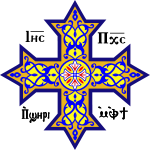Pope Cyril VI of Alexandria
| Pope Saint Cyril (Kyrillos) VI |
|
|---|---|
| 116th Pope of Alexandria & Patriarch of the See of St. Mark | |
 |
|
| Papacy began | 10 May 1959 |
| Papacy ended | 9 March 1971 |
| Predecessor | Joseph II |
| Successor | Shenouda III |
| Personal details | |
| Birth name | Azer Youssef Atta |
| Born | 8 August 1902 Damanhour, Egypt |
| Died | Script error: The function "death_date_and_age" does not exist. Cairo, Egypt |
| Buried | Monastery of Saint Mina, Alexandria, Egypt |
| Nationality | Egyptian |
| Denomination | Coptic Orthodox Christian |
| Residence | 1959-1968 Saint Mark's Coptic Orthodox Cathedral (Azbakeya) 1968-1971 Saint Mark's Coptic Orthodox Cathedral, Cairo |
| Sainthood | |
| Feast day | 9 March |
| Canonized | 20 June 2013 |
| Papal styles of Pope Cyril VI |
|
|---|---|
 |
|
| Reference style | His Holiness |
| Spoken style | Your Holiness |
| Religious style | Pope (disambiguation) and Patriarch |
| Posthumous style | Saint |
Pope St. Cyril VI of Alexandria also called Abba Kyrillos VI, born Azer Youssef Atta (8 August 1902 – 9 March 1971), 116th Pope of Alexandria & Patriarch of the See of St. Mark from 10 May 1959 to his death on 9 March 1971.
Early life
Pope Cyril VI was born in Damanhour, Egypt, into a Coptic Orthodox family. He resigned a civil service position to become a monk in July 1927. He passed his probationary period and, on 24 February 1928, took his monastic vows at the Paromeos Monastery, assuming the name of Father Mina el-Baramosy (Father Mina of the Paromeos Monastery). He was also known as Father Mina the elder.
In 1947, Father Mina built the Church of Saint Mina in Cairo. He also used to pray in the Church of the Holy Virgin in Babylon before assuming the papacy.[1]
Coptic Pope

Father Mina became Pope of Alexandria on 10 May 1959 (2 Pashons, 1675 A.M.). In accordance with the old Coptic church tradition, Pope Cyril VI was the only monk in the 20th century to be chosen for papacy without having been a bishop /Metropolitan first. Before him, there were three bishops / Metropolitans who became Popes of Alexandria: Pope John XIX (1928–1942), Pope Macarius III (1942–1944) and Pope Joseph II (1946-1956). After him, Pope Shenouda III was also a bishop before becoming Pope.[2]
Pope Cyril VI elevated the Archbishop of the Ethiopian Orthodox Tewahedo Church to the title of Patriarch-Catholicos. Abuna Basilios, who was the first Ethiopian to be appointed Archbishop of Ethiopia by Pope Joseph II, became Ethiopia's first Patriarch. Pope Cyril VI was awarded the Grand Cordon of the Star of Solomon by Emperor Haile Selassie in gratitude. In November 1959 he laid the foundation stone of the new Monastery of Saint Mina in the Desert of Mariout.
In January 1965, Pope Cyril VI presided over the Committee of Oriental Orthodox Churches in Addis Ababa, the first ecumenical and non-Chalcedonian synod of these churches held in modern times.
In June 1968, Pope Cyril received the relics of Saint Mark the Evangelist and Apostle, which had been taken from Alexandria to Venice over eleven centuries earlier. The relics were interred beneath the newly completed Cathedral of Saint Mark in Cairo, which was built under Pope Cyril and was inaugurated in a ceremony attended by President Nasser, Emperor Haile Selassie, and delegates from most other churches.
Cyril's papacy also saw marked the Apparitions of the Virgin Mary in Zeitoun, Egypt (starting on 2 April 1968).[3][4]
The Seat of Pope Cyril VI was initially located in Saint Mark's Coptic Orthodox Cathedral in Azbakeya, Cairo. However, during his papacy he built the Saint Mark's Coptic Orthodox Cathedral in Abbasseya, also in Cairo, which then became the Seat of the Coptic Orthodox Pope.
Cyril died on 9 March 1971, after a short illness. Pope Shenouda III spoke about his predecessor: "There is no man in all the history of the church like Pope Cyril VI, who was able to pray so many liturgies. He prayed more than 12,000 liturgies. This matter never happened before in the history of the Popes of Alexandria or the world, or even among the monks. He was wondrous in his prayers."[citation needed] On 20 June 2013, 42 years after his death, he was canonised as a saint by the Holy Synod of the Coptic Orthodox Church.[5]
See also
Notes
- ↑ St Mary Mons
- ↑ History of the Coptic Church, Iris Habib Elmasry Volume five.
- ↑ http://www.vice.com/read/divine-intervention-0000603-v22n3
- ↑ http://www.zeitun-eg.org/zeitoun1.htm
- ↑ Lua error in package.lua at line 80: module 'strict' not found.
References
External links
 Media related to Lua error in package.lua at line 80: module 'strict' not found. at Wikimedia Commons
Media related to Lua error in package.lua at line 80: module 'strict' not found. at Wikimedia Commons
| Oriental Orthodox titles | ||
|---|---|---|
| Preceded by | Coptic Pope 1959–1971 |
Succeeded by Shenouda III |
Lua error in package.lua at line 80: module 'strict' not found.

